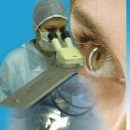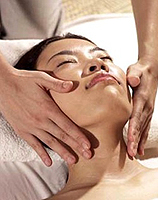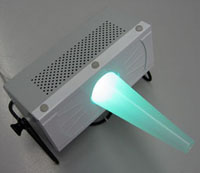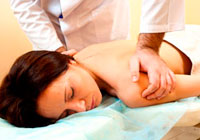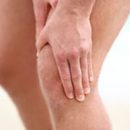Today, heat collecting is the most common method of treatment in physiotherapy. The main effect of high temperatures during thermal conducting is on the skin. When driving, dirt, clay, sand, ozokerite and paraffin are used.
Content
The concept of gasolocation
Treatment with heat - one of the oldest and most common ways of physical therapy. The main place of the thermal impact application is the skin. As a result of this impact in the skin and the layers adjacent to it, the permeability of tissue barriers and the activity of enzymatic processes.
Depending on the intensity and nature of irritation, as well as the exposure area, the response of the body can be local or overall, exciting almost all organs and systems (cardiovascular, nervous, respiratory and t.NS.). Most acute heat reacts cardiovascular system. With thermal exposure, blood vessels blood flow may vary 100 times or more. Under the influence of high temperatures, blood circulation slows down, passive expansion of capillaries occurs, the pulse is expected, and the work of the heart is hampered, while with a weathered effect of arterial pressure decreases.
The high efficiency of the procedures is related to the fact that under the action of a thermal factor, certain changes in the body occurs:
- Physical thermoregulation, breathing, tissue nutrition and metabolism change
- blood is redistributed
- Local temperature rises and active skin hyperemia develops
- Capillary blood flow and metabolic processes
- Regional dynamics improves, resulting in the passivity and muscle rigidity
- There is a resorption of inflammatory processes, scars, adhesions
Method of mud
One of the most ancient coolants are therapeutic dirt. Using the appliquancy method greatly simplified the technique of conducting procedures. The mudway has become more affordable, cheaper, in addition, it became possible to exercise it year-round and in extracurrant practice.
For therapeutic purposes, sulfide sludge, peat, gittiyevy, felling dirt and sapropels are used.
The basis of the treatment mechanism of the mud is thermal, mechanical and chemical factors.
The thermal effect is associated with the fact that therapeutic dirts have properties inherent in all coolants - high heat capacity, low thermal conductivity, lack of convection.
The thermal conductivity of therapeutic dirt depends on its mineral composition. For example, the thermal conductivity of the peat is about two times less than the thermal dirt thermal conductivity, since the content of mineral substances in the peat is significantly less than in sludge mud.
Heat Resulting Ability - The value of the reference rate of cooling, showing, for what time (in seconds) 1 g of substance with this heat capacity and thermal conductivity can change the temperature by 1 degree. The heat heading capacity of the peat is almost twice as much as the silo dirt, so its applications of the same temperature are heavier than peat dirt.
Based on the physicochemical properties of therapeutic mud, the temperature limits are installed for their healing application. So, for peat, the maximum temperature is equal to 46-48?C, and for sulfide sludge mud - 44-46?WITH. Purpose of the parameters of the procedure (temperature, extensity of the application, frequency and number of procedures per course of treatment) are determined by the state of the patient (the presence of cardiovascular diseases, pronounced vegetative violations, etc.).
Currently, packaged therapeutic muds of both domestic and foreign production are used to simplify procedures. Dirt Sestrian fields are produced - ultra-cereal high-mineralized glands, anapa sulphide, feather, peat dirt, as well as dead sea dirt. Before applying, therapeutic dirt is heated in a water bath, in hot water or a microwave oven, then applied to the body of the body to be influenced, covered with a glued and blanket.
Temperature of applications depends on the type of healing dirt, the place of its overlapping and the nature of the inflammatory process. The course of treatment is 10-15 (up to 20) procedures.
The testimony for mudships are subacute and chronic inflammatory processes in the joints, diseases of the spine, the central nervous system, the urogenital system, respiratory and digestion organs.
Application of plantation
Along with therapeutic mud as a coolant, clays are widely used. Mineral and chemical composition are extremely diverse. The specific heat capacity of the clay largely depends on the amount of water in it - the thick of the cooked clay mass, the less its heat transfer. Specific heat capacity and thermal conductivity of clay prepared for therapeutic use approximately coincides with the specific heat capacity characteristic of sludge mud, and somewhat less than that of peat clay.
For therapeutic purposes, it is consumed by clay with high viscosity, plasticity and freed from various impurities (pebbles, sand, salts of heavy metals, etc.). Before use, clay is divorced by water to the consistency of the plastic mass (instead of water it is better to use 5-10 percent. SOLITY SOLUTION). Heat clay as well as medicinal dirt on a water bath. The body area to be influenced is to be fused with a layer of heated clay with a thickness of 4-5 cm, covered with a loaf and wrapped with a blanket. Applique temperature should be 42-48?C, duration 20-30 minutes. The course of treatment is 15-20 procedures.
Indications for the plant are chronic muscle diseases, joints, spine, peripheral nerves, consequences of injuries (bone fractures, dislocation, bruises, etc.), abdominal spikes, chronic genital diseases.
Heat collecting sand or psammotherapy
Psammotherapy - Treatment with heated sand, like mud, known since Galen and Avicenna. Compared to other coolants used with the medical purpose, sand has a greater heat capacity, minor heat-conductivity and high hygroscopicity, which ensures good tolerability of hot procedures. They have a pronounced force action. This contributes to the hygroscopicity of sand, which ensures unhindered sweating during the procedure.
In addition to heat sand, it has a mechanical action - irritation of skin receptors in the form of a gentle surface massage. As a result of such an impact, blood circulation and lymph circulation are stimulated, sweating increases. This causes stimulation of oxidative processes, improving the kidney function, loss of body weight (up to 600-1000 g per course). Sandwinds have an painful effect, reduce the edema of the joints, contribute to the increase in mobility in them.
Psammotherapy is carried out in the form of common and local baths. Sandbaths of solar heating spend on the seashore, lakes and rivers. To do this, form a medallion with a thickness of 10-15 cm in size in human growth. The sand temperature must be 45-46?WITH. In front of the bathroom, the patient carefully wipes the towel and put on the medallion, headed into the shadow, put the napkin, moistened with cool water. The patient's body is covered with a layer of sand in 5-6 cm, the region of the heart and abdomen is left open (you can put a layer of sand in 1-2 cm on the stomach).
The temperature of the baths are constantly adjusted to 48-50?WITH. High temperatures are transferred easily because the body overheating does not occur due to abundant sweating. Duration of shared adult bath 25-30 minutes, for children 10-15-30 minutes. After the bath, the patient takes a shower or bathes in a reservoir, then easily dressed resting in the shade of 30-40 minutes.
Local sandbaths are carried out on the limbs, separate joints, lower back. The temperature of the sand for local baths may be higher than for general - up to 55-60?C, duration from 30-40 to 60 minutes. Procedures are carried out in a day or two days in a row (on the third break), for the course 12-15 (up to 20) procedures.
Heat collecting paraffin
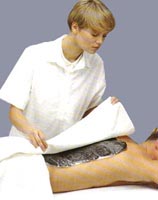 At the beginning of the twentieth century, paraffin - a mixture of extreme hydrocarbons, chemically lowactive began to use paraffin as a coolant. It is obtained mainly of oil. In the practice of paraffin, they use purified, dehydrated paraffin, containing up to 2.3 percent. Mineral oils.
At the beginning of the twentieth century, paraffin - a mixture of extreme hydrocarbons, chemically lowactive began to use paraffin as a coolant. It is obtained mainly of oil. In the practice of paraffin, they use purified, dehydrated paraffin, containing up to 2.3 percent. Mineral oils.
Physical feature of paraffin - its ability to expand when heated and, accordingly, decrease in volume when cooled. Thus, when conducting the procedure, paraffin has a soft compression effect, which makes it possible to transfer heat to more deeply located tissues and ensure the activation of nutritional processes in them.
Local use of paraffin causes antisparty, painful and absorption action. Under the influence of paraffin, the blood circulation and lymph circulation, troofs of the skin and the tissue are subject to tissue, the edema decreases, scars soften.
When conducting paraffinization by laying melted paraffin at a temperature of 55-65?C applied a layer 1-2 cm with a flat brush, covered with a loaf and wrapped with a blanket. Temperature of this applique of about 50?WITH.
Procedures continue from 30 to 60 minutes, they are carried out daily or every other day, for the course - 15-20 procedures. After each procedure, the patient should relax at least 30-40 minutes.
Treatment of ozokeritis
Another medical coolant is ozokerite - a product of oil origin. It consists of a mixture of hydrocarbons: solid paraffin rows and gaseous (methane, ethane, ethylene, propylene), mineral oils, resinous substances, carbon dioxide and hydrogen sulfide gas.
The effect of ozokerite appliqué is made up of two phases: In the first 5-40 seconds, spasm (sharp narrowing) of capillaries occurs, then a resistant expansion of them is developing with an increase in the capillary network. Hyperemia (redness) is caused by the extension of vessels (redness) persists after the applique is removed within an hour.
The basis of the action of ozocerite on the body is not only its unique properties of the coolant, but also chemical and biological characteristics. Chemicals presented in ozozesely with ceresine, asphalt and resins, have an irritating effect on the skin, and biological substances, penetrating through intact areas, affect the nervous system.
Therapeutic effect is manifested by a restering, anti-inflammatory, painful, desensitizing (anti-allergic), antispastic and regenerating effect.
The main healing methods of ozokeritol are the same as parafinocations: layering, saloon-appliquancy, cuevetically appliquancy, ozokerite baths. Gynecological practice applies vaginal tampons from ozokerite or ozokerlin (40 percent. ozokerite and 60 percent. Vaseline Oil).
Ozocenite treatment is prescribed in chronic diseases of various localization. It is used in arthrological practice, traumatology and surgery, with diseases of the nervous system, female sexual sphere, in ophthalmology, with skin diseases and T.D.

